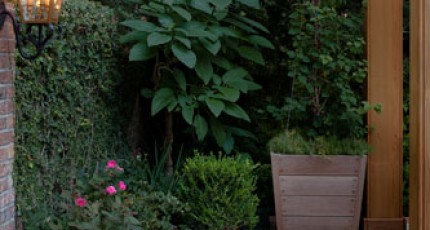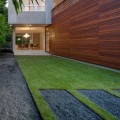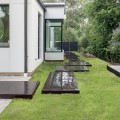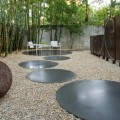Minimal Garden

In a minimal garden, hardscapes are used to define geometric shapes and linear movements that correspond to home and landscape architectural motifs.
One of the most common hardscapes used to create such boundaries is a custom patio. Because contemporary and modern design so heavily favor the inorganic as building blocks of décor, concrete and polished stone surfaces of many different varieties can be used to frame mixtures of gravel, décor, and plants.
This is a very common method of creating a linear form such as a square, rectangle, l-shape, or deviation of a triangular form that corresponds to an architectural keynote of a house. If a radial arc or circular form is needed, a concrete retaining wall or modernesque masonry wall can be constructed to house the garden.
Keep in mind that with any geometry found on a contemporary landscape, actual forms may not follow the exact proportions of geometric shapes as they are typically envisioned. Some are highly deviated in order to emphasize the abstract, avant garde, and surreal.
In a minimal garden, space itself becomes a type of form.
Due to the high level of customization that this form of garden design involves, space within walls and patio surfaces also creates a sort of negative geometry. By negative we do not mean bad, but rather the inverse of the perceived norm (think of the negative on a film prior to development.)
This negative space can be manipulated to jump out at the eyes much like images on a film negative.
This is often accomplished by very simple, but precise, combinations of colors that automatically invert within the mind if a person stares at them for any length.
One very popular method is to take black polished stones and lay them out in an alternating grid, leaving open spaces that are then filled with white gravel. This creates a staggered checkerboard design into which low growth vegetation or very small trees are strategically introduced to create the sensation that life is tenuously emerging out of some sort of shifting mystical void.
Keep in mind as well that not all space has to be filled in a minimal garden.
There is much to be said about the concept of nothingness, or the void as some would call it, in the realms of spirituality, art, and philosophy.
This goes hand in hand with the mentalist nature of minimalism as a reductionary approach to reality that strips away illusion and forces us to create thought from the centerpoint of negated assumptions.
Emptiness that would otherwise appear as a deficit to other garden styles actually takes on a strange power of its own in a minimal garden.
In these gardens, plants are carefully chosen only to highlight geometric principles.
Right angles may be punctuated by shrubs or small trees at points of intersection. Radii may be established by planting thin layers of slow-growing shrubs and whit flowering plant that forms a layered buffer of organics pushing against the boundaries of the absolute.
Dark green plants and white flowers are preferred over plants with light green leaves and brightly colored flowers. This is because they better compliment the contrasting whites, blacks, and grays used in minimal garden hardscape elements.





